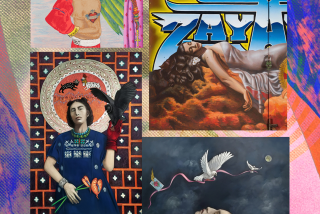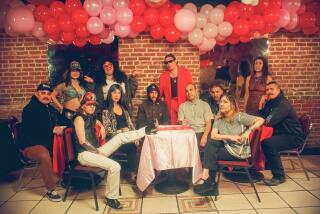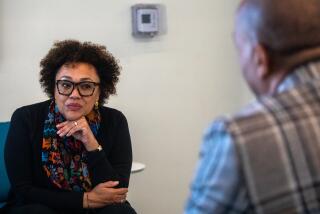A NETWORK OF ARTISTS IN L.A.
- Share via
“This is an incredible way to network with women all over the country. I came to recharge my batteries,” said Carol MacDonald, who traveled from Vermont this week to attend the Women’s Caucus for Art annual conference in Los Angeles.
“I need a little communication with other artists,” said Harriet Zeitlin, who left the isolation of her West Los Angeles studio to attend the gathering. “This is so stimulating; it’s the kind of thing that turns you around.”
MacDonald and Zeitlin were among about 200 artists, educators, historians and curators who gathered Tuesday morning in a sunny courtyard at USC to register for the five-day conference. Their meeting progressed into a panel on “How Can a Woman Artist Keep Her Name Alive?,” a box lunch, a program on “Women in Film” and a ceremony honoring six senior “women of distinction.”
In convivial proceedings the caucus cited accomplished pioneers noted for their independence and aesthetic achievements: architect Eleanor Raymond, Jewish art scholar Rachel Wischnitzer and artists Minna Citron, Clyde Connell, Joyce Treiman and June Wayne. Examples of their work are on view at USC’s Helen Lindhurst Fine Arts Gallery through Feb. 23.
During a reception at the small gallery after the ceremony, a crush of admirers shook the hands of the artists and asked for their autographs. “Do you want me to make some untoward remarks?” Treiman jokingly asked a reporter. “Well, I didn’t expect to be moved by this, but I am. I think it’s a very nice honor.” In the meantime, other artists and scholars were convening downtown or gearing up for coming events in a citywide triumvirate of art conventions.
The visitors--and local professionals--participating in the meetings can be identified by name tags, registration packets and acronyms: WCA, ARLIS/NA and CAA.
Women--and occasional men--convening under the WCA banner belong to the Women’s Caucus for Art, a nationwide organization of more than 3,000 members who have united to support and recognize the efforts of women in art. Caucus programs (at USC and the Biltmore Hotel) cover practical, aesthetic and philosophical issues in panels and symposiums and encompass exhibitions in dozens of museums and galleries.
The 382 people bearing ARLIS/NA paraphernalia are affiliated with the Art Libraries Society of North America, a 1,200-member association of art and architecture librarians, visual resource curators and other record keepers. Their weeklong meeting (mostly based at the Hyatt Regency Hotel downtown) draws to a close this afternoon with an up-to-date workshop on “Automation--Implementing Standards in Visual Resource Collections” at the J. Paul Getty Center for the History of Art and the Humanities.
The 3,500 to 4,000 art folks expected to wear the CAA badge today through Saturday represent nearly half the membership of the College Art Assn. The 73-year-old organization of art historians and educators, museum directors and curators was founded “to raise the standards of scholarship and of the teaching of art and art history throughout the country.” Its annual meeting functions as a clearinghouse for employment and as a scholarly forum.
The focus of the converging conferences is strictly professional and academic, but for every proper scholar presenting a paper in a stuffy hotel auditorium there are hundreds of people engaged in other activities. They have been perusing displays of visual arts materials, buying feminist T-shirts and publications, purchasing artist Joe Fay’s souvenir poster of the librarians’ meeting, anxiously inspecting the job market, visiting art exhibitions all over Southern California, renewing old friendships and yelling, “Hey, how are you? It’s good to see you.”
The sun cooperated with conference planners by shining brightly on the opening day of the Women’s Caucus for Art, prompting veiled threats to leave chilly homes and stay here. When Terry Gibbs stood up to speak at a caucus awards ceremony, she confessed, “Those of us from the Northeast are enjoying the weather as much as the conference.”
Like all academic conferences, this trio has reasons for being that go beyond formal education. ARLIS/NA Executive Director Pamela Jeffcott Parry of Tucson says members of her organization sign up for such meetings to promote “professional contacts” with the “two major constituencies” most likely to use art librarians’ services--artists and art historians.
“Our program is far more ambitious and longer than usual this year. I think that reflects the strong desire of our members to come to California,” she commented.
The Art Libraries Society presented its annual Gerd Muehsam award (for a paper by a graduate student in library science) to Jane Dunbar Johnson of the Library of Congress. Her winning project was “Main Entry and the Art Exhibition Catalogue,” done while she was a UCLA student.
The society’s Wittenborn awards for art publishing went to the Yale University Press for general excellence; the J. B. Speed Art Museum, in association with the Indiana University Press, for “Ingres, the Pursuit of Perfection: The Art of J.A.D. Ingres” by Patricia Condon; the University of California Press for “French Gothic Architecture of the 12th and 13th Centuries” by Jean Bony; Harry Abrams Inc., in association with the Detroit Institute of Arts and the Metropolitan Museum of Art, for “Design in America: The Cranbrook Vision 1925-1950,” and Krause International for “The Print Council Index to Oeuvres-Catalogues of Prints by European and American Artists.”
One of the lighter points of the librarians’ generally sober sessions came during a panel on Southern California oral history projects. Writer Lawrence Weschler regaled the audience with tales of Edward Kienholz’s practice of bartering with his interviewer, a midnight sabotage of Weschler’s tape recorder and the artist’s taped complaints that a pretty girl wasn’t sent to record his life story. Participants were also treated to excerpts from Weschler’s recent videotape interview of David Hockney, directed by the Archives of American Art.
It’s no accident that the three organizations have converged in Los Angeles and overlapped their meetings. The Art Libraries Society became affiliated with the College Art Assn. several years ago and convenes with it about two of every three years, according to Parry.
The Women’s Caucus for Art is a 13-year-old child of the venerable College Art Assn. “It began in 1972 as a caucus of CAA, composed of academic women,” said Ruth Weisberg, a USC faculty member who co-chaired this year’s caucus conference with Linda Jo Russell. Although the group’s annual meeting is always held in conjunction with College Art, the women’s caucus has been an independent organization since 1977, when it broadened its membership to include artists. It now has 31 chapters across the country.
“The Women’s Caucus for Art is a forum for affirmative action and equity for artists as a whole,” Weisberg said. “It’s also an advocacy group. I don’t think things are fair now (for women and minorities), but I do think we’re in a position to make things happen.”
While all three organizations develop extensive independent programs, they also coordinate their efforts in joint ventures. ARLIS/NA and WCA offered combined advice on artists’ self-promotion and record keeping, ARLIS/NA and CAA joined forces in a series of papers called “The Artist and the Critic,” and a WCA panel addressing the question “Are There Female and Male Traditions in Performance Art?” will take place at 4:45 p.m. today under auspices of the CAA at the Biltmore.
More to Read
The biggest entertainment stories
Get our big stories about Hollywood, film, television, music, arts, culture and more right in your inbox as soon as they publish.
You may occasionally receive promotional content from the Los Angeles Times.










